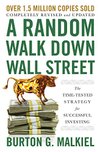A Random Walk Down Wall Street: The Time-Tested Strategy for Successful Investing (Twelfth Edition)
amazon.com
Saved by BrightFutureGuy and
A Random Walk Down Wall Street: The Time-Tested Strategy for Successful Investing (Twelfth Edition)

Saved by BrightFutureGuy and
Technical analysis is the method of predicting the appropriate time to buy or sell a stock used by those believing in the castle-in-the-air view of stock pricing. Fundamental analysis is the technique of applying the tenets of the firm-foundation theory to the selection of individual stocks.
Rule 2: A rational investor should pay a higher price for a share, other things equal, the larger the proportion of a company’s earnings paid out in cash dividends or used to buy back stock.
the clear conclusion is that, in every case, the market did correct itself. The market eventually corrects any irrationality—albeit in its own slow, inexorable fashion.
It is not hard to make money in the market. What is hard to avoid is the alluring temptation to throw your money away on short, get-rich-quick speculative binges.
“In crowds it is stupidity and not mother-wit that is accumulated,” Gustave Le Bon noted in his 1895 classic on crowd psychology.
The key to investing is not how much an industry will affect society or even how much it will grow, but rather its ability to make and sustain profits.
Determinant 4: The level of market interest rates.
Rule 3: A rational (and risk-averse) investor should pay a higher price for a share, other things equal, the less risky the company’s stock.
The fundamentalist uses four basic determinants to help estimate the proper value for any stock. Determinant 1: The expected growth rate.